Guest Country
JAPAN, THE CENTER ”AT THE END OF THE WORLD”
The Nation One Should Learn From
It wasn’t Japanese economy that created the Japanese spirit, culture, ethics, view of the world, Samurai tradition. It was completely the opposite. The Japanese learned from others and soon became better than them. Learn from others, remain faithful to oneself. This ancient moral led them through millennia, showing their superiority in different times and situations, until the present day. Parallely with their economic and technological successes, the Japanese began influencing the world trends in art, philosophy, sports, fashion, nutrition, way of life. Zen Buddhism, martial arts, ikebana, bonsai, origami, macrobiotic nutrition – these are only some of the numerous Japanese ”products” that conquered the world during previous decades. At this year’s International Book Fair in Belgrade, and in this issue of ”National Review”, Japan is a special guest
By: Dragan Milenković
 Japan is a special country. A country of unusual culture, interesting customs, original nutrition, society organization, philosophy, art and literature. Although they adopted a lot from ancient China and Korea, learned a lot from the West, the Japanese knew how to adjust everything to themselves, to reform and convert it so that it becomes purely Japanese. Japan is a special country. A country of unusual culture, interesting customs, original nutrition, society organization, philosophy, art and literature. Although they adopted a lot from ancient China and Korea, learned a lot from the West, the Japanese knew how to adjust everything to themselves, to reform and convert it so that it becomes purely Japanese.
Not a single country had such a strong influence during the past decades on international developments and trends, in the area of philosophy, culture, nutrition, economy, sports, entertainment and way of life – as Japan did. Zen Buddhism, martial arts, ikebana, bonsai, origami, macrobiotic nutrition, karaoke, are only some of the ”products” of a county geographically located ”at the very end of the world”. It covers an area not larger than Italy, with scarce natural and energy resources, but with incredible human potential, hard-working, persistent, disciplined, creative people who do well anything they begin, and continue doing it to the very end.
The economic development of Japan never ceased to attract the attention of international public. Impressive economic and financial results, modern structure of economy, dynamic development, dominance in the area of electronics, robotics, automobile and chemical industry in the 1960s and 1970s continued with the spreading of Japanese supremacy in many other economic segments. All these results, often called ”the Japanese miracle” were achieved in a situation of complete scarceness of natural potentials, which adds another element of incredibility to the ”miracle”.
SURPASSING THE TEACHER
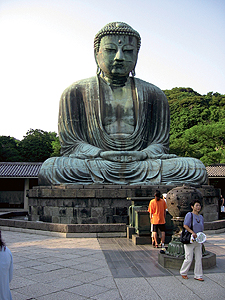 Most authors who write about Japan agree in one thing: besides the purely economic analysis of the country’s success, one must not neglect the socio-historical circumstances which brought Japan to its present economic progress. During their long history, the Japanese showed what good students they are, and that they soon surpass their teachers. The first teachers of the Japanese were, of course, the Chinese, from whom the Japanese received the first fruits of culture in the V century, as well as economy. Most authors who write about Japan agree in one thing: besides the purely economic analysis of the country’s success, one must not neglect the socio-historical circumstances which brought Japan to its present economic progress. During their long history, the Japanese showed what good students they are, and that they soon surpass their teachers. The first teachers of the Japanese were, of course, the Chinese, from whom the Japanese received the first fruits of culture in the V century, as well as economy.
The inhabitants of the Great Chinese Empire, one of the most advanced and most developed countries of the world at the time, gave the Japanese the Buddhist religion, literacy, the basis of state establishment, as well as the then achievements in agriculture and crafts.
The Japanese soon advanced in many fields, and already from the VIII century, China began importing from Japan objects made of lacquered ornamented wood and weapons, very appreciated in China. As a nation, from the very beginnings, the Japanese showed a strong feeling for aesthetics and rationalization. The Chinese often used to conclude, with a bit of envy, that after a while, certain Chinese products experience such improvement in Japan, that later they could hardly be recognized even in their country of origin.
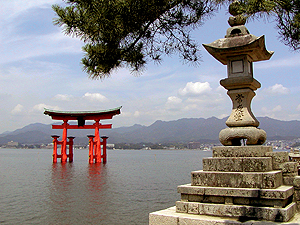 The largest part of Japan’s territory consists of mountains and heights, while valleys and lowlands cover not more than 32 percent of the total area. Long mountain chains in the middle of the main islands separate Japan in two parts, one facing the Pacific and the other facing the Sea of Japan. Rivers, fast and short, flow from the mountains and into the Sea and the Ocean. The largest part of Japan’s territory consists of mountains and heights, while valleys and lowlands cover not more than 32 percent of the total area. Long mountain chains in the middle of the main islands separate Japan in two parts, one facing the Pacific and the other facing the Sea of Japan. Rivers, fast and short, flow from the mountains and into the Sea and the Ocean.
The Japanese archipelago is one of the world’s most earthquake-prone areas – earthquakes are very often. There are many warm mineral springs, geysers, as well as volcanoes. At present, there are 60 active volcanoes in Japan and many of those considered extinct. One of them is the beautiful mountain Fuji, one of the national symbols of Japan.
Although not among the ones largest by area, Japan was always among the most populated countries. About 33 million people lived in Japan in mid-XIX century, while data from 1992 state that the population of Japan at the end of the XX century was 124,5 million, which makes Japan the seventh largest nation in the world.
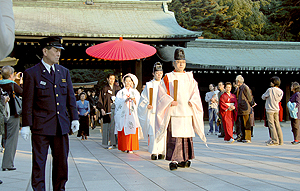 The same imperial family (dynasty) has been ruling Japan for the last 2.660 years – which is a world record. During the XI century, the clans of warriors became stronger in Japan, which led to establishing the class of samurais, whose eminent representatives, such as the regents and the shoguns, slowly began taking authority from the emperor. Japan was under foreign influence only for a short while, in the second half of the XVI century, when Catholic missionaries from Portugal managed to convert several hundreds of thousands people into Christian faith. However, sensing the danger from foreign influences, the shoguns from the Tokugawa family ordered the banishment of Christians in 1603 and almost complete isolation, which lasted two and a half centuries. The same imperial family (dynasty) has been ruling Japan for the last 2.660 years – which is a world record. During the XI century, the clans of warriors became stronger in Japan, which led to establishing the class of samurais, whose eminent representatives, such as the regents and the shoguns, slowly began taking authority from the emperor. Japan was under foreign influence only for a short while, in the second half of the XVI century, when Catholic missionaries from Portugal managed to convert several hundreds of thousands people into Christian faith. However, sensing the danger from foreign influences, the shoguns from the Tokugawa family ordered the banishment of Christians in 1603 and almost complete isolation, which lasted two and a half centuries.
RAISING FROM THE ASHES
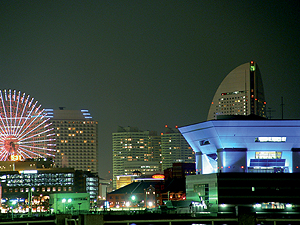 The death penalty awaited the Japanese who would leave the island, and foreigners were forbidden to dock their ships at Japan’s shores, except for several Dutch ships per year in the Nagasaki harbor. Japan did separate itself from the world for a long time, but developed a completely unique culture. Due to its isolation from the world, Japan succeeded, unlike most Asian countries, to avoid becoming a victim of the Western European colonial forces’ invasion. The death penalty awaited the Japanese who would leave the island, and foreigners were forbidden to dock their ships at Japan’s shores, except for several Dutch ships per year in the Nagasaki harbor. Japan did separate itself from the world for a long time, but developed a completely unique culture. Due to its isolation from the world, Japan succeeded, unlike most Asian countries, to avoid becoming a victim of the Western European colonial forces’ invasion.
Japan reopened towards the world in 1858, under the pressure of the Americans, who needed a station in the Pacific where their whale hunters would get water, food, coal supplies and other necessities. The Japanese were amazed by the newcomers’ technological superiority, which forced them to accept most of the American requests. They immediately began rearranging the country and rapidly adopting Western knowledge and technology. The country industrialized, modernized, became economically stronger, while the Japanese life experienced a true revolution. The samurais were no longer permitted to wear swords, they had to cut off their queues, and social classes were canceled.
 The country became economically and military stronger, in accordance with the motto of the then political elite ”fukoku kiohei” (enrich the country, strengthen the army). Japan expressed its interests in Korea and began sending troops to China, led a war against imperial Russia and spectacularly won, in World War II it became member of the three-party pact with fascist Germany and Italy, and got into war with the USA. After the initial successes, the Japanese war machine got tired. After the bombarding of Tokyo and other cities, the USA dropped two nuclear bombs on the Japanese cities of Hiroshima and Nagasaki in August 1945, immediately killing several hundreds of thousands civilians. After USSR also entered the war, Japan capitulated on August 15, 1945, not being able to resist the doubled strength of the opponent. The country became economically and military stronger, in accordance with the motto of the then political elite ”fukoku kiohei” (enrich the country, strengthen the army). Japan expressed its interests in Korea and began sending troops to China, led a war against imperial Russia and spectacularly won, in World War II it became member of the three-party pact with fascist Germany and Italy, and got into war with the USA. After the initial successes, the Japanese war machine got tired. After the bombarding of Tokyo and other cities, the USA dropped two nuclear bombs on the Japanese cities of Hiroshima and Nagasaki in August 1945, immediately killing several hundreds of thousands civilians. After USSR also entered the war, Japan capitulated on August 15, 1945, not being able to resist the doubled strength of the opponent.
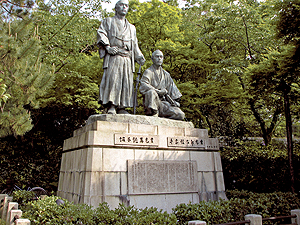 The burned down and destroyed land, population without food and basic necessities – many years of suffering awaited Japan under occupation. The country was practically ruled by the Americans. They initiated a series of social and economic reforms, but kept Japan under strong control. Japan was predicted with a long period of poverty; however, self-assertion and working enthusiasm, the social consciousness of common people, enthusiasm of the individuals and incredible wish for success, began rising the country’s economy from the ashes. The burned down and destroyed land, population without food and basic necessities – many years of suffering awaited Japan under occupation. The country was practically ruled by the Americans. They initiated a series of social and economic reforms, but kept Japan under strong control. Japan was predicted with a long period of poverty; however, self-assertion and working enthusiasm, the social consciousness of common people, enthusiasm of the individuals and incredible wish for success, began rising the country’s economy from the ashes.
Less than twenty years after the end of World War II, the hard work of the Japanese people led to such results that the world began talking about the ”Japanese economic miracle”. Parallely with the economic and technological successes, the Japanese began influencing the world trends in art, philosophy, sports, fashion, nutrition, way of life. 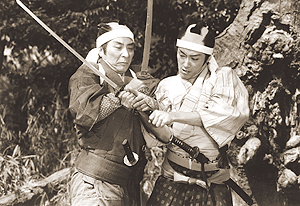 In the late XX and early XXI century, Japan is one of the economically and technologically strongest, most famous, most interesting and most influential countries of the world. In the late XX and early XXI century, Japan is one of the economically and technologically strongest, most famous, most interesting and most influential countries of the world.
Most people who visited Japan agree that this country would have never become one of the world leaders if, along with adopting foreign results, it had not preserved strong bonds with its own tradition, and maintained the organization of the society and the state almost the same as in the times of the shoguns. Great investments in education, care for the people, and at the same time subordinating individual interests to the interests of the nation, brought Japan to the present degree of development, which undoubtedly places it among the leading countries of the world.
***
Origin of the Sun
The Japanese call their country Nihon or Nippon. In Chinese ideograms, which are officially used in Japan, this name is written with two ideograms, one signifying the sun, and the other a book, or origin. Hence, the name of Japan can be interpreted as ”the origin of the sun”, after which Japan was probably given the name ”Land of the Rising Sun”.
***
Islands
The territory of Japan consists of four large and about 3.900 smaller islands. They spread from the north-east to the south-west, along the eastern coast of the Asian continent, from 30 to 46 degrees north latitude, with a total length of about 2.400 kilometers.
|
